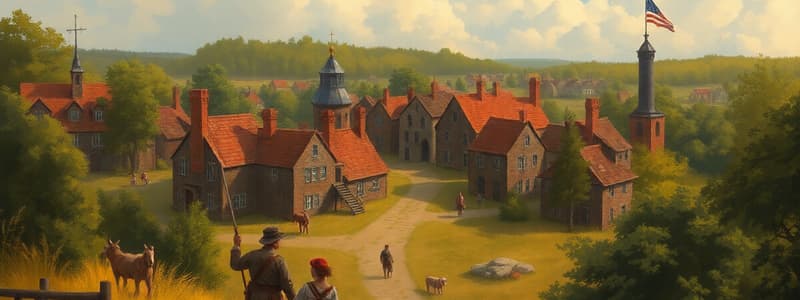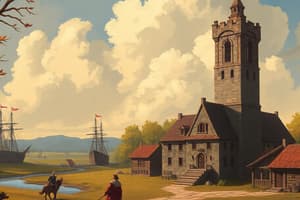Podcast
Questions and Answers
Why did the Calverts want to establish a colony in North America, and how did their motivations differ from those of the Virginia Company?
Why did the Calverts want to establish a colony in North America, and how did their motivations differ from those of the Virginia Company?
The Calverts wanted to make money and create a refuge for Catholics, who faced religious discrimination in England. The Virginia Company was primarily focused on economic gain.
Explain how the Calverts applied the lessons learned from Jamestown when planning the Maryland Colony.
Explain how the Calverts applied the lessons learned from Jamestown when planning the Maryland Colony.
The Calverts carefully planned to avoid the 'starving time' experienced in Jamestown, likely focusing on adequate supplies and agricultural planning.
What was the primary economic activity in both Virginia and Maryland, and how did it shape the social structure of these colonies?
What was the primary economic activity in both Virginia and Maryland, and how did it shape the social structure of these colonies?
The primary economic activity was tobacco farming. Large plantations led to a society with wealthy landowners and a population of smaller farmers and indentured servants.
What was the significance of the Toleration Act in the Maryland Colony, and what eventual change occurred regarding religious rule in the late 1600s?
What was the significance of the Toleration Act in the Maryland Colony, and what eventual change occurred regarding religious rule in the late 1600s?
In the image, people are depicted carrying a cross. What does this detail suggest about the Calverts' intentions for the Maryland Colony?
In the image, people are depicted carrying a cross. What does this detail suggest about the Calverts' intentions for the Maryland Colony?
Compare and contrast the governance structures of Virginia and Maryland, highlighting the roles of the king and the Calverts.
Compare and contrast the governance structures of Virginia and Maryland, highlighting the roles of the king and the Calverts.
How did the initial composition of colonists in Maryland, particularly the presence of indentured servants, influence the colony's social and economic structure?
How did the initial composition of colonists in Maryland, particularly the presence of indentured servants, influence the colony's social and economic structure?
Explain the significance of the Toleration Act of 1649 in Maryland. How did the religious landscape of the colony evolve after its enactment?
Explain the significance of the Toleration Act of 1649 in Maryland. How did the religious landscape of the colony evolve after its enactment?
Why was the Carolina colony established and what challenges did the Lords Proprietors face in governing it?
Why was the Carolina colony established and what challenges did the Lords Proprietors face in governing it?
How did the introduction of rice cultivation transform the economy and demographics of South Carolina?
How did the introduction of rice cultivation transform the economy and demographics of South Carolina?
Flashcards
Virginia & Maryland government similarities
Virginia & Maryland government similarities
Virginia and Maryland both had governors and elected assemblies.
Maryland Toleration Act (1649)
Maryland Toleration Act (1649)
Gave religious freedom to all Christians in the colony of Maryland in 1649.
Proprietary Colony
Proprietary Colony
A colony controlled by individuals or groups granted land by the king.
Carolina Colony Creation
Carolina Colony Creation
Signup and view all the flashcards
South Carolina's Rice Economy
South Carolina's Rice Economy
Signup and view all the flashcards
Founding of Maryland
Founding of Maryland
Signup and view all the flashcards
Cecilius Calvert
Cecilius Calvert
Signup and view all the flashcards
Leonard Calvert
Leonard Calvert
Signup and view all the flashcards
Maryland's Planning
Maryland's Planning
Signup and view all the flashcards
St. Mary's City
St. Mary's City
Signup and view all the flashcards
Study Notes
- The Maryland Colony was founded by the Calverts, a wealthy English Catholic family.
- The Calverts wanted to create a profitable colony in North America and a refuge for Catholics, who faced worship restrictions in England.
The Calverts
- George Calvert, also known as Lord Baltimore, invested in the Virginia Company.
- He requested a colony charter from King Charles I for land north of Virginia along Chesapeake Bay.
- George Calvert passed away in 1632, before the charter was officially granted.
- Cecilius Calvert inherited the title of Lord Baltimore and became the owner of the new colony, naming it Maryland.
- Cecilius Calvert appointed his brother, Leonard, as Maryland's first governor.
- The Calvert brothers learned from the struggles in the Jamestown Virginia Colony, carefully planning to avoid a "starving time" in Maryland.
- In 1633, the Calverts dispatched the first group of colonists to Maryland, predominantly indentured servants.
- The colonists established their first settlement near the mouth of the Potomac River, now known as St. Mary's City.
Life in Maryland and Virginia
- The Maryland Colony shared similarities with its neighbor, Virginia.
- Both colonies were separated by the Chesapeake Bay and the Potomac River, sharing a mild climate conducive to growing tobacco on the Coastal Plain's fertile soil.
Farming
- Some Maryland colonists grew rich cultivating tobacco on large plantations.
- Many colonists struggled on small farms, often starting as indentured servants.
- Maryland's government supported former servants by providing them with land, clothes, tools, and corn.
Government
- Virginia was the most populous English colony in North America in the early 1700s, and Williamsburg became its capital in 1699.
- Virginia and Maryland had similar government systems, with governors and elected assemblies.
- The king controlled Virginia, while the Calverts governed the Maryland proprietary colony.
- Maryland passed the Toleration Act in 1649, granting religious freedom to all Christians in the colony.
- The Anglican Church became the official church of Maryland in 1702, after a period of increased settlement by its members.
The Carolina Colonies
- More people moved to Maryland and Virginia to acquire more land.
- In 1663, King Charles II granted land to establish another colony called Carolina.
Lords Proprietors
- Carolina divided among eight English leaders known as the Lords Proprietors.
- They adopted a constitution, or written government plan, for Carolina in 1669. -Free white male colonists could elect leaders and create laws.
- However the proprietors and king retained most of the power.
- Governance of Carolina proved challenging due to its size.
- Colonists often disregarded inconvenient laws, resulting in the split of the colony into North and South Carolina in 1712.
- North Carolina farmers grew tobacco and corn in the hilly terrain.
- South Carolina farmers struggled to profit from tobacco due to the wet land.
- Enslaved African workers shared their rice cultivation knowledge.
- Rice became South Carolina's primary crop, increasing the population of enslaved people.
Georgia
- England, France, and Spain wanted the area south of South Carolina.
- King George II sent colonists to control the area by 1727
- James Oglethorpe led the effort, suggesting that English debtors be sent to settle a new colony.
- Settlers would defend the land, while the debtors had a chance at a fresh start.
- King George II granted Oglethorpe a charter for Georgia in 1733.
Slavery
- Georgia's leaders restricted farm sizes and prohibited slavery, leading to plantations being absent.
- The settlers varied amongst thier views on slavery.
- Georgia permitted slavery in 1751.
- Georgia's economy began to rely on plantations and enslaved Africans just like the other Southern Colonies
Heading West
- Most towns, farms, and plantations arose near the coast, on the Coastal Plain in the early 1700s.
- The Piedmont, the land between the Coastal Plain and the Appalachian Mountains, had few settlers.
- This land was called the backcountry because it lay "in back of" the settled area by Europeans.
The Great Wagon Road
- Thick forests, rocky hills, and scarce roads made backcountry travel difficult.
- Settlers began moving west of the Coastal Plain by the mid-1700s.
- German immigrants from Pennsylvania began populating the Virginia, and Carolina backcountry.
- The settlers followed a Native American trail that grew wide enough for wagons over time.
- This path became known as the Great Wagon Road.
- The Great Wagon Road went through the Shenandoah Valley and east of the Blue Ridge Mountains.
- It gave the only access for wagons with household goods to the backcountry.
Conflicts with Native Americans
- Thousands of Cherokee, Creek, Powhatan, and other Native American people resided in the areas that later became the Southern Colonies.
- Europeans arrived, and built settlements on land near the Native Americans.
- Just like in the New England Colonies, there were conflicts between Native Americans and European settlers.
The Tuscarora War
- German and Swiss settlers demolished a Tuscarora village to build a new settlement in North Carolina.
- Some colonist felt that the remaining Native Americans were not treated justly.
- One settler beleived other colonists were cheating and not allowing them to hunt near thier lands.
- Their land losses made the Tuscarora attack several settlements in 1711.
- The Tuscarora aimed to scare the settlers, but led to the Tuscarora War.
- Almost 950 Tuscarora were killed or sold into slavery after war ended in 1713.
- Settlers kept pushing Native Americans off their lands in the Southern Colonies.
- Captives were sent to the West Indies to work on sugarcane plantations.
- There were even peaceful Native American that died in large numbers, and lost fighting in war.
Studying That Suits You
Use AI to generate personalized quizzes and flashcards to suit your learning preferences.
Related Documents
Description
The Maryland Colony was founded by the Calverts, a wealthy English Catholic family, seeking profit and religious refuge. George Calvert's vision was realized by his son, Cecilius, who established Maryland. The Calverts learned from earlier colonial struggles to ensure the colony's success.



